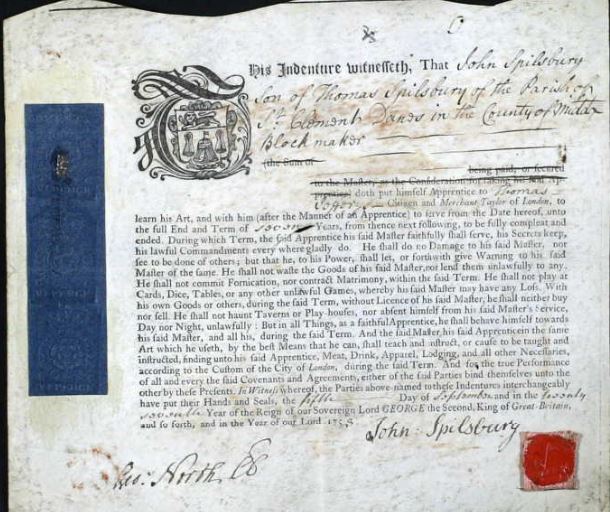Although John Spilsbury lived for a mere 30 years, his legacy to the world is one that will be remembered by many, as he was the inventor of what we know today as, the jigsaw puzzle. What do we know about his short life?
John was one of three boys born to Thomas and Mary Spilsbury, a block maker (a person who engraved or set up the clocks used in block printing). Another son Jonathon became a renowned engraver in London, whilst Thomas, who appears to have been the youngest son, became an outstanding printer, said to be able to print French accurately.
Today though, we’re going to take a glimpse into the life of the John. In 1753 John began a seven year apprenticeship to Thomas Jefferys (1719-1771), Geographer to King George III.

John’s Apprenticeship
It would appear that John left London after completing his apprenticeship and travelled to Suffolk where he met Sarah, the daughter of John May with the couple marrying at Newmarket on 30 July 1761.
Just over a year after they married Sarah gave birth to an infant whose life was to be short lived, as was so common at that time, a daughter, Mary, however, two years later a second child, Sarah was born whilst the couple lived in Newmarket, Suffolk.
At some stage after this they moved back to London where John set up his own business using the skills learnt from Jefferys, but John was to take a slightly different route to his master, and created what would become known at the time as, ‘dissected maps’.
In the early 1760’s John decided to paste an engraved map onto a thin sheet of mahogany, cut it up along the country or county borders, jumbled the pieces together and advertised them for sale in a box, to be reassembled. With that the jigsaw began its life being sold from his print shop in Russell Court, London.
His trade card apparently listed some 30 different dissected maps on sale at his print shop, with prices ranging from 7 shilling and sixpence to £1 1 shilling. Such prices made them quite expensive, but this was due to the price of the wood use and the box used to house it. The puzzles were educational, to teach people about the known countries of the world, but as they were expensive, they were limited to only those with plenty of money to spare.

This cabinet belonged to Lady Charlotte Finch, Royal Governess to the children of George III. She had it commissioned to hold several dissected map puzzles, which she had created for the royal children. V&A
This diversion from his main print business wasn’t to last for very long as John died on 3 April 1769. Only six days after John’s death, newly widowed Sarah took their newborn son, also named John, to be baptised at St Martin in the Fields parish church, young John being born the previous day.
In December 1767 John wrote his will, in it he left his estate, including his business stock to his wife Sarah, plus £100 to his daughter, Sarah who was, by this time working in the family firm. The money was held in trust until she reached the full age of twenty one. He also left £20 to ‘each of my brothers and sisters’. His will was proven 10 April 1769.

London Packet 5 April 1771
Sarah wasted little time in marrying for a second time, her new husband was Henry Ashby (1744-1818), who coincidently, had also worked with Thomas Jefferys with the couple marrying in November 1769.

You can just see the Ashby name on this trade card, in tiny writing in the middle, at the bottom of the card.
Although Sarah took over her husband’s business of jigsaw making, it eventually merged into Henry’s engraving business, but it’s good to see Mrs Spilsbury’s name in print, this text appears just beneath the header image, as well as in the advert for the dissected maps, above.

Despite the businesses change of direction, the concept of jigsaw puzzles survived and here we have it referenced in Jane Austen’s Mansfield Park, when Fanny Price was derided by her cousin because she
cannot put the map of Europe together or my cousin cannot tell the principal rivers in Russia, or, she never heard of Asia Minor, or she does not know the or she does not know the difference between water-colours and crayons! How strange! Did you ever hear anything so stupid?’
‘

How interesting. Do you know which other people then made “dissected maps” and “dissected pictures” in the late 18th and early 19th century. Doing a quick google search comes up with https://en.wikipedia.org/wiki/Jigsaw_puzzle#History and this article by Wentworth Puzzles – https://www.wentworthpuzzles.com/2019/05/07/history-of-jigsaw-puzzles
But neither seem to have a list of makers
LikeLike
Slightly later there was a Charles Dilly in the 1780’s and George Riley in the 1790’s, but I haven’t found any more in the 18th century 🙂
LikeLike
Pingback: Merkwaardig (week 19) | www.weyerman.nl
I rather like the term “dissected maps.” It would not have been possible to call these early works “jigsaw puzzles” because as far as I can determine jigsaws weren’t invented until the 1800’s.
Peter
LikeLike
Yes, I also prefer the original name. The term jigsaw didn’t come about until towards the end of the 19th century 🙂
LikeLiked by 1 person